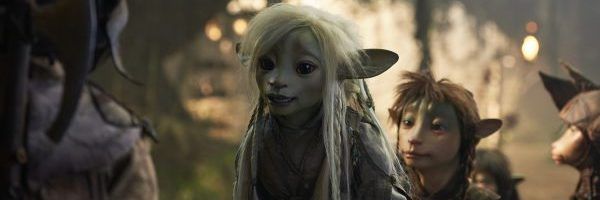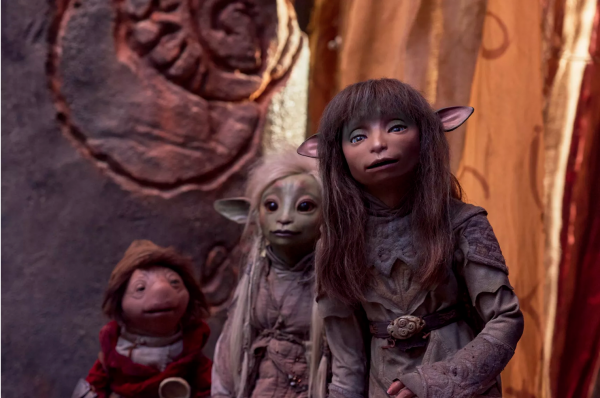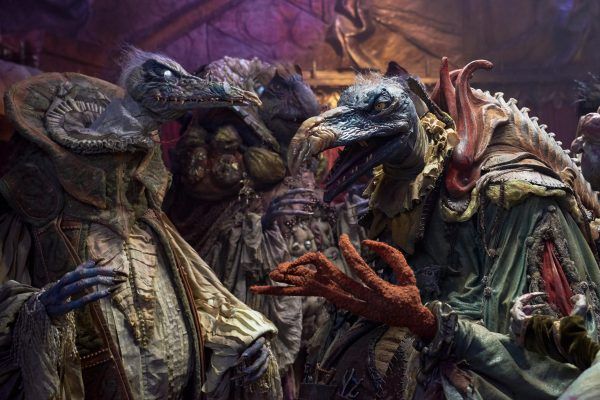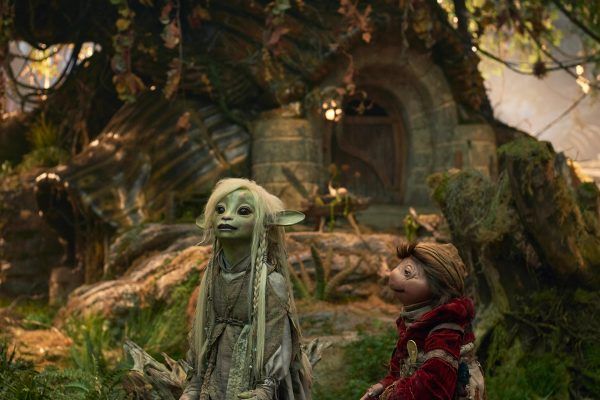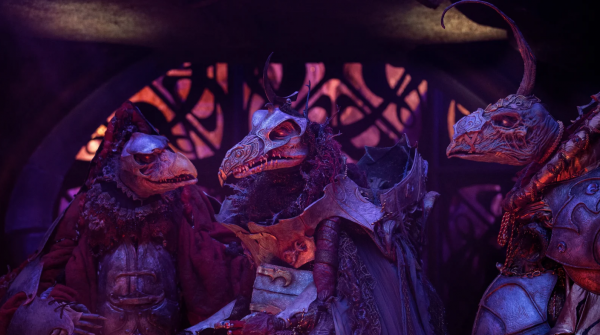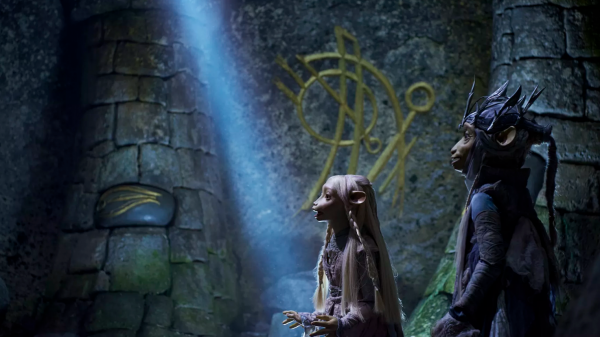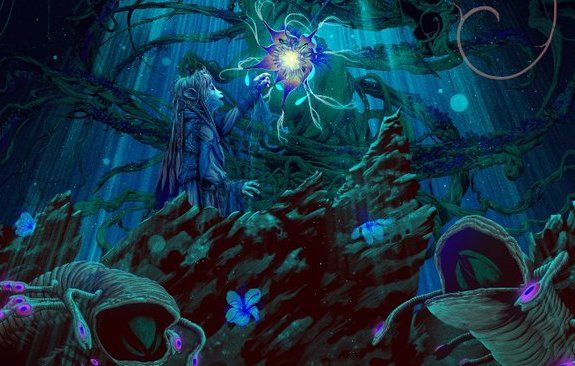The 10-episode Netflix original series The Dark Crystal: Age of Resistance, being released 37 years after the original film, is a breathtaking, beautiful and terrifying return to the world of Thra. When three Gelfling – Rian (voiced by Taron Egerton), Brea (voiced by Anya Taylor-Joy) and Deet (voiced by Nathalie Emmanuel) – discover the horrific secret behind the power of the Skeksis, the fires of rebellion are lit and an epic battle for the planet begins.
Collider recently got the opportunity to sit down with show creators/co-executive producers Jeffrey Addiss and Will Matthews, as well as writer/co-executive producer Javier Grillo-Marxuach, to talk about approaching the show as a high fantasy story for everyone and not just a show for kids, how this evolved from a desire to pitch an idea for Labyrinth 2, fleshing out the story for a 10-episode season and beyond, the need to have all of these scripts ready prior to shooting, how working with puppets affected things on set, pairing actors with the right puppet character’s performance, working with a filmmaker as collaborative as Louis Leterrier (who directed all of the episodes), how long they could see all of this going for, and which puppet they’d like to take home from the set.
Collider: I’m very excited that this TV series exists, and that it still very much has the dark and scary tone of the film.
JAVIER GRILLO-MARXUACH: One of our mottos was, “No childhood left unscarred.” We embraced the darkness.
JEFFREY ADDISS: We certainly talk a lot about the darkness and a lot about how dark it was gonna go. We were very conscious of not doing that just randomly. We always had to have a story reason, but if there was one, we would go there. We were not afraid of it.
GRILLO-MARXUACH: We never looked at this as a show for kids. I think that because the puppets are in it and because the Jim Henson Company has done so much work in that space, people assume that it’s a show for children, but this is high fantasy for everyone. That much said, I think Jim Henson held kids in much higher esteem than a lot of other people who make children’s television. He knew kids were tough and resilient, and that if you showed them the darkness, they would be able to take it and process it in a positive way. That’s what you see in the film, and I think that was our idea, going into this, too. Everybody talks about how terrifying the movie is, and it is, but we never thought, “Okay, we’re just gonna be terrifying, for the sake of being terrifying.”
And there’s something just so magical about getting to see the actual puppets.
GRILLO-MARXUACH: Walking onto the set of The Dark Crystal, Jeff had been there for months already because he was the on-set producer/writer, but Will and I went there a good three months into production, and they were filming the Crystal Chamber and a Skeksis banquet. If you were allowed to visit the set of The Force Awakens and say, “Oh, I’m in the middle of the Falcon. How exciting?” But then, Han Solo walks in, and he’s 70 and got white hair and is kind of crotchety.” When you walk into the Crystal Chamber, the Skeksis are exactly the same. It’s literally like you’re walking into the screen, Purple Rose of Cairo style, in 1982, and it’s staggering. You’ve literally walked into your childhood.
ADDISS: We built so many of the hallways, you could get lost in them.
After you spend time on a set like this, how do you go back to regular normal life?
ADDISS: You’re eager to go back to regular life because you don’t see the sun while you’re there. We shot all of it indoors. We had one exterior shot that we did, that wasn’t plates or backgrounds, when we went out to the parking lot to burn a puppet. That was our only exterior. Everything else was inside. So, when you come out of it, there’s a feeling of, “What is the real world anymore?” But you’re also grateful to see the sun.
GRILLO-MARXUACH: What’s amazing is that, when you look at these sets and everything in this show, you’re watching artisans working at the peak of their talent. There were people who worked on the show, who built puppets and wardrobe and wigs in the original. All of these people have all of that experience, and the artists that we got are of such a class and quality. There are things on the set like hand-painted backgrounds, and that’s a technology that doesn’t get used a lot in Hollywood. Now, you just throw up a green screen and put up a background, but we had things like that. It was like stepping into an era of filmmaking that doesn’t exist anymore, and that gives you an appreciation for the craftsmanship and the commitment of the artists. When you say, “How would you go back to normal life?,” it can be difficult because normal life isn’t nearly as beautifully rendered as those sets were.
Jeff and Will, you guys came to this by way of Labyrinth 2, which is an unusual bit of a journey. How did you originally end up coming up with an idea for Labyrinth 2?
ADDISS: That’s what we do for fun. Will and I have been writing together for 10 years, and he didn’t drink when I met him, so I introduced him to alcohol and weird puppet movies from the ‘80s. We just would sit around for fun and break stories on things that we loved. It was an exercise, for us. So, we were literally sitting in a bar having some drinks and talking about how you would do Labyrinth 2, shortly after [David] Bowie passed away. That’s why it was in the zeitgeist. So, we came up with something that we loved and thought, “Let’s call the Henson Company,” and it has led to this, which is so crazy.
Were you surprised about calling them and having them say, “We’re not interested in that, but we do have this”?
ADDISS: Oh, yeah! It was a dream idea, to throw [our idea for Labyrinth 2] out there and see what happens. But to have them come back and say, “What about The Dark Crystal?,” was incredible, so we jumped at it.
WILL MATTHEWS: Our first meeting was with Lisa Henson, in her office on the Henson lot. You’re just trying to look cool and keep it together, but you’re looking at all the toys and all of this stuff and you’re like, “This is where they make childhood dreams!”
ADDISS: And then, there’s the first time you step into the Creature Shop and have that experience, which is overwhelming. Then, there’s the first time that you see a Skeksis built, and the first time you see a Gelfling, and the first time that you see a Fizzgig. Have you ever seen a hairless Fizzgig? It’s terrifying!
GRILLO-MARXUACH: That’s the headline, “Have you ever seen a hairless Fizzgig?” Their experience is like if you called George Lucas and said, “Hey, we wanna remake Tucker, the Man and His Dream,” and they’re like, “Nah, but I’ve got this thing called A New Hope. You wanna remake that?” Like, what?!?
How did you then come up with an idea for The Dark Crystal?
MATTHEWS: We went back to the bar, and got back to work. Jeff and I stayed up all night and worked on our pitch for a sequel feature film. And then, we went in and met Lisa Henson, and she said, “I’m so glad you’re here to tell me your idea for our prequel TV show.” And we were like, “Yup, no problem. Got it. Here we go!” You just meet and talk about it and share ideas. And then, you go in for another meeting, and (director/executive producer) Louis Leterrier was at that one, and that one went well. And then, a couple of weeks later, you’re pitching the whole series to Netflix, and you’re off and running.
How close is all of this to what that pitch was?
ADDISS: Very close, in terms of the markers. Very close, in terms of setting where the flags go, along the journey. This show is about half of what we pitched. There is a second half, waiting to be told, if we get the chance. You plant your flags, and they’re pretty darn close. We had the lead characters, or at least the ideas of them. That’s when Javi [Grillo-Marxuach] and the writers’ room came in, and we started fleshing it all out, because there’s a lot of space between those gaps. You do a 25-minute pitch, but we’re doing a 10-hour show, so there’s a lot of story left to break and come up with, and that takes you into some surprising directions. Seladon wasn’t a character that was a big part of the pitch, at all. That came from Louis and the writers’ room, who fleshed out that character and brought her to life. She’s a much bigger and more complex part of the show than we had originally imagined. At the same time, there are moments that are right out of that original pitch. It’s amazing.
Jeff and Will, how did you come to work with Javier Grillo-Marxuach, and find a groove together while you were working on this?
MATTHEWS: It was brutal because Javi’s so mean.
GRILLO-MARXUACH: And we clearly don’t get along and have nothing in common. I’m a screamer, and I like to create problems that only I can solve. No. We hit it off, immediately. We’re all birds of a feather. We’re cut from a similar cloth, and we like a lot of the same things.
MATTHEWS: Jeff and I pitched the show, wrote the pilot, did the test, and got the green light, but then, they called us up and were like, “You guys have never been in a room before, nevermind led a room before, so now, we’re gonna bring in someone to help.” And a lot of times, that help can go quite badly. But Javi had written that essay about the laws of showrunning, that I read every year, and it just could not have gone better. That’s really a testament to Javi.
GRILLO-MARXUACH: And to you guys. We had a great time. At the end of the day, when you look at the show, among the many things that I’m proud of about the show is that ,when you look at the scripts, we broke that season together. They had written the pilot, but we broke the season together, and we rewrote together. We worked with all of the writers on their stories, and our fingerprints, as a group, are everywhere. It’s so seldom that you get to have that kind of simpatico with other writers, and that shared sense of mission. It’s great.
ADDISS: There are lines and things that we don’t remember who wrote anymore. Louie was also in the writers’ room, as well, for a lot of it. It was very collaborative. We had our director in the room with us. When we would maybe start to go down roads, Louie, who’s very gentle and very magnanimous, would quietly be like, “I don’t know how to do that. I don’t know how to shoot that. Can we find another way?”
GRILLO-MARXUACH: There was also that time where we went, “Yeah, write whatever you want. And then, at the premiere, you can see what I did with it.” Feature directors tend to cast a big shadow because they’ve worked at that level and they’re renowned for doing the kinds of films Louie has done. So, [Jeff and Will] had their scary experience meeting me, but for me, the fear I had was, “Oh, my god, I’m gonna go work with this huge feature director. What’s that power dynamic gonna look like?” Louie is the showrunner of record on this show, and he directed every episode. For me, one of the nicest surprises was coming in and finding that Louie was such a generous, collaborative, gentle guy. He literally gave me the shirt off his back, one day.
MATTHEWS: It happened. Javi said to him, “Hey, I like your jacket.” and Louie said, “Here, you take it.” Then, I said, “Louie, I like your car,” and got nothing!
GRILLO-MARXUACH: That’s what we hope we can take to our projects, outside of this, if there are any because I think we could do The Dark Crystal for a long time. Hopefully, there will be more. The Jim Henson ethos is all about unity and collaboration. We like to say that working at the Jim Henson Company is a team sport. We’re all coming at this because we want to honor Jim Henson’s legacy. We all have to come together and find common ground, which is what the show is about. It’s also what the process of making the show was about. It was beautiful because most egos were checked at the door.
ADDISS: That process goes all the way down the line, through production and post-production, as well. There’s a lot that you can do with puppets in post, before we would bring in the voice actors. We could change and find things, find new moments and find bits of bobs of things to put together. I don’t think there’s a single scene that we shot, that isn’t in the show, though. That’s how efficient we got at it. How much we had the same single vision is that, if anything, we would add a few scenes because we felt like we needed a little bit more or a little bit there, but I really don’t think there’s a scene we shot that’s not in the show.
MATTHEWS: And with that level of efficacy, it’s still the longest shoot in Netflix history. Puppets are very slow and very expensive.
GRILLO-MARXUACH: And they’re very temperamental. Sometimes their ears would fall off. They were like, “No, my latex is itching!”
Did you have to have all of these scripts written before shooting?
ADDISS: Oh, yeah, we had all 10 when we started production. We were in preproduction simultaneously with the writing, so the Creature Shop was literally designing and building as we were writing, so it became a conversation, back and forth. Brian Froud was doing art while we were writing. We had access to all of the archives and everything he had done before, but a lot of times, we would invent things. It would go to Brian and go through him, and then it would come back to us and we would rewrite because there would be some brilliant ideas in there. It was all happening, at the same time, but coming out of that room, we had 10 scripts. And then, you get on set and things change. We learned better ways of getting from A to B. We learned how the puppets move, and what was working and wasn’t working, and we’d start adding scenes. We moved some stuff around, in the structure of the show, which is really nice, when you have one director doing all of it. There are things in certain episodes that were originally gonna be in other episodes, but we have a branching storyline, so it allows us to start to move pieces around to create the best episode.
Was there anything you learned about the puppets that most changed things?
ADDISS: Yes, how they handle objects, specifically. Picking things up is very difficult. That’s a rig. You start to write around that. Flooring becomes a conversation that you wouldn’t believe. You start to learn tricks of ways where we can minimize moves or floors for the puppeteers coming in and out of rooms. It’s all about little tricks to make things easier. There was never a thing where we couldn’t do something because it’s a puppet. The Creature Shop would find a way.
What’s it like to see the finished product? Can you enjoy it, even though you know how it’s done?
MATTHEWS: There are different degrees. Jeff cannot. I can, sometimes. Javi can, most of the time.
ADDISS: Because I was doing so much of the sound and the voice recording and everything, and was on set for all of it, I know the show’s every breath, inside and out. I put together those spreadsheets with the sound team, of 10,000 lines that all had to be broken down, assigned, written, matched, rewritten and tweaked. So, I know every breath, literally, of the show.
MATTHEWS: Because they write in, “Gasp!, and then you have to do that.
GRILLO-MARXUACH: The really interesting thing about the show is that the spirit of collaboration goes all the way to the performances. The characters are composite characters that are created by very different disciplines. Because we’re not casting, but we’re building our cast, you have designers who are literally trying to figure out what the archetype is that the character represents, and how we tell that story through design. Then, you’ve got your puppeteers, who are performers that are making dramatic choices on stage, about how the character moves and expresses themselves, and they’re saying the dialogue with the mouth movements. They are actors in this show. And then, you’ve got the voice actors coming in to put the cherry on top of that, which is the voice of the character, but they have to match the mouth movements and acting choices that were done on set. So, you have designers, puppet performers and voice actors, all coming together and meeting each other, at different lengths of the way, to create these characters. When you watch the show, if you know anything about how it was made, you can’t help but marvel at the complexity of it, and also wonder how Jeff, as our on-set write/ producer didn’t just have a nervous breakdown.
When you step back and look at the scale and scope of the whole thing, how did you even keep track of it all?
GRILLO-MARXUACH: Louie had this big chief notebook, and he wrote on it with a pencil.
ADDISS: There were a couple of us that had the whole show in our brains, and it was a lot about helping Louie, when he couldn’t hold all parts of it, and being there to support him. I was by his side, the entire time, except when he was running around the pit. He literally shot the show. He’s crazy. But the job is that you trust that you have a good team, and everybody holds big parts of it in their brain. My job was to hold on to the story, but that meant that sometimes I forgot my cousins’ names because I knew the name of every Podling. There’s just a limited amount of brain space. So, when it was done, I got to let some of that go, and that was huge. I could remember my cousin’s name again. I literally couldn’t remember my cousin’s name, even though I grew up with him.
It seems like it would have been really easy to find a voice cast for this because who wouldn’t want to voice a character for this. Was that the case?
ADDISS: Taron [Egerton] signed on because he’s a huge fan. When Taron came in, the first day that he visited the set, his first question was, “Is Roundup in it?” Roundup is a deep cut character from the creation myth, and he knew that. When Taron came on board, that really helped. People’s relationship to The Dark Crystal really helped, and people’s relationship with the Jim Henson Company and Jim Henson really helped, as well. None of them got rich off of this. It was a labor of love.
GRILLO-MARXUACH: Also, our casting directors were amazing. They announced the show and everybody came out of the woodwork saying, “Hey, we wanna work on it,” but somebody has to actually get that past the finish line and find the talent for each character. The amazingness of our voice cast is not due only to interest in the property. It’s also due to a lot of hard work by people who worked on the show, that were trying to help us tell the story, in their own way.
How did you pair an actor with a character?
ADDISS: You start with the character. If you know that people are interested or express interest, if there’s not a character for them, they’re just in that pool, floating in that ether. You’re always coming at it through the character. We would start from, who’s the character? What does the character sound like? What feels right? And then, you create a list off of that. But Taron was the first offer that we made. Taron was in our brains when we wrote the thing, and it was amazing to get him. And then, there were people who came on board that we never would’ve thought of, but somebody said it in the room and, suddenly, it felt right. It was a combination of things.
What was it about Taron Egerton that made you want him for this?
ADDISS: That he naturally has a sense of charisma and of a little bit of fun. If you’ve seen him in Kingsman, that comes through in his voice. His voice felt a little bit more grounded to me than the voice of Jen did, that felt a little more pure and perfect. We wanted a character that could feel a little bit more rough and tumble, and a little more Hans Solo-ish.
MATTHEWS: Rian is a tricky character. We inherited him, and he had a pretty set backstory. In the beginning stages, he was listing a little towards an unlikable small town quarterback because his perspective, going in, is that he believes the Skeksis. He is status quo guy. He wants it to continue, and he’s good at that. And since you know the Skeksis are bad, you can initially be like, “Rian is not a good guy. He’s not helping.” And Taron is just so likable and energetic and believably sweet that you are on Rian’s side, when you hear him explain why he wants to impress his father. It doesn’t sound selfish.
Clearly, it sounds like you guys have one more story than you could fit into these 10 episodes. Do you have a pretty solid Season 2, if that happens?
GRILLO-MARXUACH: We have a document. We’ve broken that season. One of the things is that, because it’s a prequel, it begs for an answer to some of the things that are going on in the movie, even though we’re telling a story that has its own integrity. When you go into the movie, a lot has happened in Thra. Jen and Kira are the last two Gelfling, and people wonder about how that happened. They’re gonnna come to this show and wonder that. One of the great things about Will and Jeff’s idea for what the story had to be is that they came up with an answer for what happened to all of the Gelfling. While I cannot tell you, it’s certainly something that we hope to develop in the future of this show, and it’s an answer that’s mind-blowing. You can watch the film and make a lot of assumptions about what happened in Thra, but Thra is a really big place, and there’s a lot of room for hope and for story. Their answer for how it is that Thra went from here to what it is in the film is something that’s gonna surprise a lot of people, and it’s gonna break down a lot of assumptions about what the world of The Dark Crystal is and what it’s about.
Have you thought about how many seasons you might have before you catch up to the movie?
ADDISS: We have an idea, roughly, of how many seasons this story is. And then, depending on the success of the show and what new stories they want, there are other places to go and other stories to tell, within this big world. That could mean jumping time, or jumping over here or there. So, we have other stories, but we really think of them as stories with a beginning, middle and end. That’s just the way our brains work. This show is so big and complicated, it was always about, “Let’s tell this story, and then let’s tell the next one, if people wanna see it.” We’ve been on this season for three and a half years, to get to this point. It’s a long process.
MATTHEWS: Maybe you’ll get four more seasons in another 70 years.
ADDISS: At this rate, four more seasons would be 12 years. But there are a lot of people who can tell stories in The Dark Crystal world. We’re just excited that we get to run the ball for a little while, and we’re gonna run it in the best way that we can, but we have an end that we’re all running towards.
MATTHEWS: The ending is very important to us. How long the middle is, is up to the audience.
GRILLO-MARXUACH: The thing about The Dark Crystal is that Jim Henson, Frank Oz, (writer) David Odell, (producer) Gary Kurtz and that entire gang created is so fertile and it has inspired so many people. That’s why this isn’t the first time The Dark Crystal has resurfaced since the movie was released. There’s been comic books, guidebooks, creation myths books, and novels. So, we really look at this as, we were brought in to be the caretakers of a garden that has been very carefully cultivated by the Jim Henson Company and his heirs for awhile. We get to cultivate now, and we get to trim some things and change some plants, but the garden is gonna stay past our existence there because it’s something that transcends us and transcends most of the people working on it. At this point, it has gone through so many hands, but all of those hands are loving, believing hands, so this world has become its own thing.
ADDISS: When you walk onto the set, it’s shot very differently and it has its own sense of pace. It feels like its own story, but set in the same world. That was always how we thought about it. It’s a different lens, but the same world. That’s really a testament to the designers, to Louie and to the Frounds.
MATTHEWS: It also speaks to how much everyone involved loves the original. Everyone is rowing in the same direction because everyone loves that North star. No one is really trying to fix or improve or change. You’re just trying to fill out, and you can see that.
If at the end of all this, they tell you that you can have one of these puppets to take home, which one would you want to have with you?
MATTHEWS: Hup.
ADDISS: Hup is a really good choice ‘cause I’m also thinking about the size of my home. I live in an apartment, so I’m not sure I could fit a Skeksi anywhere. But you know what? I’d take a Skeksi, and I’m gonna say that it would be The Heretic.
GRILLO-MARXUACH: I have a weird answer for that. One of my contributions to the show is this thing, called The Crucible of Many Anvils, which is where the Stone-in-the-Wood Gelfling throw their old weapons and they get smelted. It’s a big set piece. I fought for The Crucible of Many Anvils, and it was my thing. Then, when I finally got on the set, I was like, “It’s the Crucible!” So, I don’t want a puppet. I want The Crucible of Many Anvils. It has a light inside of it, so it can also be a lamp.
The Dark Crystal: Age of Resistance is available to stream at Netflix on August 30th.

